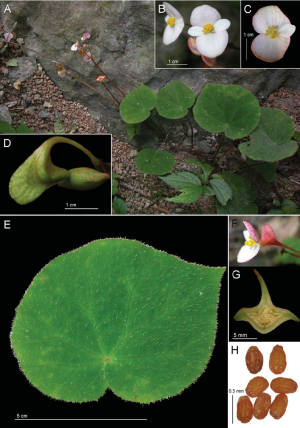Begonia curvicarpa
Species Information
Classification and Distribution
Begonia curvicarpa is a species of Begonia native to the karst area in southern China. It was first described and published by S. M. Ku, C.-I Peng & Y. Liu in 2004.
Habitat
This species typically grows on limestone rocks or at the entrance of semishady to shady, slightly moist caves.
Characteristics
Begonia curvicarpa is a monoecious, perennial, and rhizomatous plant. The rhizome is succulent, creeping, elongate, somewhat zigzag, brown, and sparsely hairy. It has internodes that range from 1.5 to 5.5 cm long. The stipules are often persistent, triangular, sparsely hairy along the midrib, soon glabrescent on the abaxial surface. They are thickly herbaceous, brownish to reddish-brown, approximately 10 mm long and 9 mm wide, with an aristate apex and entire margins.
he leaves are alternate, sparsely pilose on the adaxial surface and villous on the abaxial surface. They are simple, asymmetric, obliquely broadly ovate to orbiculate, thin chartaceous, and green above, with the lower surface being green to reddish. The leaves measure between 6 and 10 cm long (including basal lobes) and 4-9 cm wide. The apex is acute to acuminate, rarely obtuse, and the base is cordate. The margin is denticulate or ciliate-dentate, sometimes crenate. Venation is basally 6-7-palmate, pinnate along the midrib, with 2-3(-4) major lateral veins on each side. Petioles are brown, terete, 7-12 (-17) cm long, and 2-4 mm in diameter, slightly reflexed and crisp-hairy.
Flower Details
Inflorescences are axillary, arising from the rhizome, cymose, and 1-3 branched, with 3-5 flowers. Peduncles are well-developed, brown to brownish-green, measuring up to 9-12 cm long and 2-3 mm in diameter, and they can be erect or ascending. Pedicels are reddish to brownish with many red flecks, ascending in staminate flowers and horizontal to pendent in carpellate flowers. Bracts are caducous, oblong, elliptic to ovate, herbaceous, green to reddish, and measure 4-8 (-10) mm long and 3-4 (-6) mm wide, with an obtuse apex and ciliate-serrate margins.
Tepals are glabrous, with entire margins. Staminate flowers have 4 tepals, with the outer 2 white to pinkish on the adaxial surface and pink on the abaxial surface with reddish flecks. They are broadly ovate to ovate-orbicular, with a slightly cordate base and a rounded apex, measuring 13-15 mm long and 15-17 mm wide. The inner 2 tepals are white, oblanceolate, and have an obtuse apex, measuring about 12 mm long and 6 mm wide. The androecium is zygomorphic, with stamens numbering 35-40 and having a golf-club shape. Filaments are free, nearly equal in length at about 2 mm long, and anthers are 2-locular, slightly compressed, oblong, and have a slightly emarginate apex, appearing yellowish and measuring about 1.2 mm long.
Carpellate flowers consist of 3 tepals, with the outer two being white to pinkish on the adaxial surface and pink on the abaxial surface, occasionally white on both surfaces. They are broadly ovate to ovate-orbiculate, with a rounded apex, measuring 14-17 mm long and 15-17 mm wide. The inner tepal is obtrullate to oblanceolate. The ovary is glabrous, pinkish, and adorned with many red flecks. It is somewhat curved and 3-winged, with unequal wings. The lateral wings are much narrower, curved, and thick, measuring 3-4 mm high, while the abaxial wing is elliptic or nearly triangular, measuring 6-7 mm high and 7-8 mm wide. The locule is 1, with intruded parietal placentation. There are 3 styles that are fused in the lower 1/3, yellow, and measure 4-5 mm long, with the top split into a rounded U-shape. The stigmas are U-form and somewhat spiraled.
Etymology
The specific epithet "curvicarpa" is derived from Latin and means "curved fruit," referring to the distinctly curved fruits of this species.
Comparison to Similar Species
Begonia curvicarpa resembles B. porteri H. Lév. & Vaniot but can be distinguished by its longer rhizome internodes (1.5-5.5 cm; 0.8-1.7 cm in B. porteri) and its distinctly curved fruits.
References
- Ku, S.-M., Peng, C.-I., & Liu, Y. (2004). Notes on Begonia (sect. Coelocentrum, Begoniaceae) from Guangxi, China, with the report of two new species. Botanical Bulletin of Academia Sinica, 45, 353-364.
Photos
External Links
Links to pages related to this species
